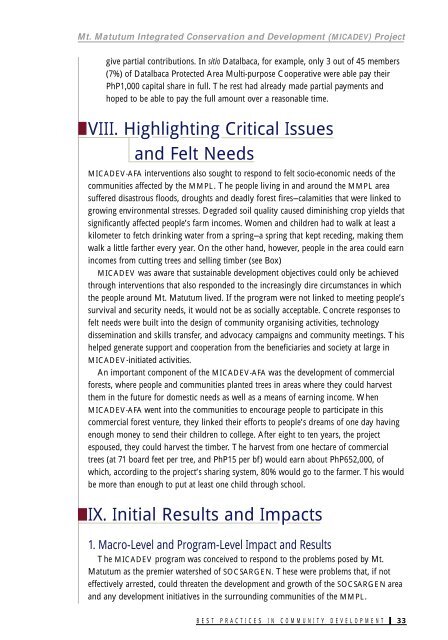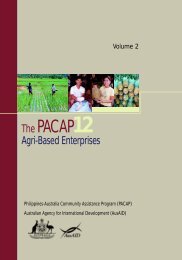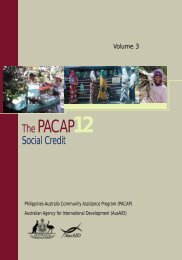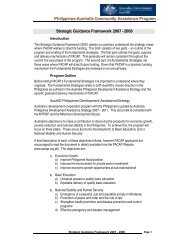The PACAP12
The PACAP12
The PACAP12
Create successful ePaper yourself
Turn your PDF publications into a flip-book with our unique Google optimized e-Paper software.
Mt. Matutum Integrated Conservation and Development (MICADEV) Project<br />
give partial contributions. In sitio Datalbaca, for example, only 3 out of 45 members<br />
(7%) of Datalbaca Protected Area Multi-purpose Cooperative were able pay their<br />
PhP1,000 capital share in full. <strong>The</strong> rest had already made partial payments and<br />
hoped to be able to pay the full amount over a reasonable time.<br />
VIII. Highlighting Critical Issues<br />
and Felt Needs<br />
MICADEV-AFA interventions also sought to respond to felt socio-economic needs of the<br />
communities affected by the MMPL. <strong>The</strong> people living in and around the MMPL area<br />
suffered disastrous floods, droughts and deadly forest fires—calamities that were linked to<br />
growing environmental stresses. Degraded soil quality caused diminishing crop yields that<br />
significantly affected people’s farm incomes. Women and children had to walk at least a<br />
kilometer to fetch drinking water from a spring—a spring that kept receding, making them<br />
walk a little farther every year. On the other hand, however, people in the area could earn<br />
incomes from cutting trees and selling timber (see Box)<br />
MICADEV was aware that sustainable development objectives could only be achieved<br />
through interventions that also responded to the increasingly dire circumstances in which<br />
the people around Mt. Matutum lived. If the program were not linked to meeting people’s<br />
survival and security needs, it would not be as socially acceptable. Concrete responses to<br />
felt needs were built into the design of community organising activities, technology<br />
dissemination and skills transfer, and advocacy campaigns and community meetings. This<br />
helped generate support and cooperation from the beneficiaries and society at large in<br />
MICADEV-initiated activities.<br />
An important component of the MICADEV-AFA was the development of commercial<br />
forests, where people and communities planted trees in areas where they could harvest<br />
them in the future for domestic needs as well as a means of earning income. When<br />
MICADEV-AFA went into the communities to encourage people to participate in this<br />
commercial forest venture, they linked their efforts to people’s dreams of one day having<br />
enough money to send their children to college. After eight to ten years, the project<br />
espoused, they could harvest the timber. <strong>The</strong> harvest from one hectare of commercial<br />
trees (at 71 board feet per tree, and PhP15 per bf) would earn about PhP652,000, of<br />
which, according to the project’s sharing system, 80% would go to the farmer. This would<br />
be more than enough to put at least one child through school.<br />
IX. Initial Results and Impacts<br />
1. Macro-Level and Program-Level Impact and Results<br />
<strong>The</strong> MICADEV program was conceived to respond to the problems posed by Mt.<br />
Matutum as the premier watershed of SOCSARGEN. <strong>The</strong>se were problems that, if not<br />
effectively arrested, could threaten the development and growth of the SOCSARGEN area<br />
and any development initiatives in the surrounding communities of the MMPL.<br />
B E S T P R A C T I C E S I N C O M M U N I T Y D E V E L O P M E N T 33







